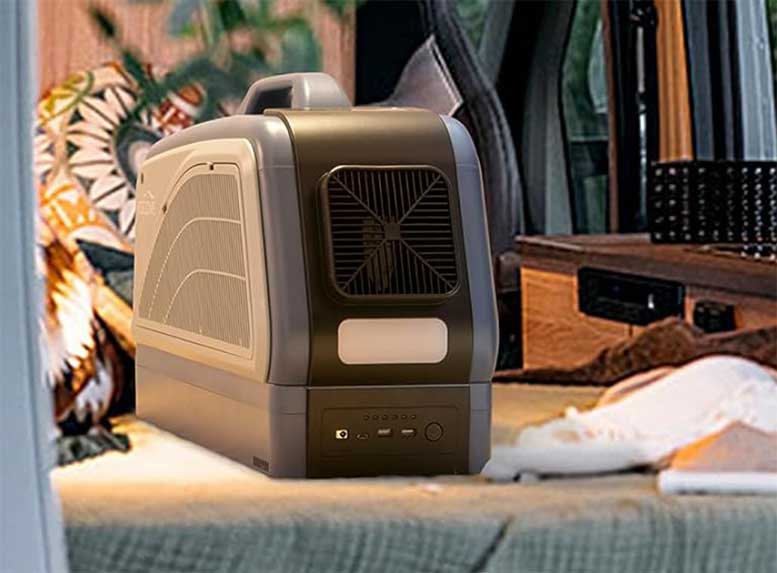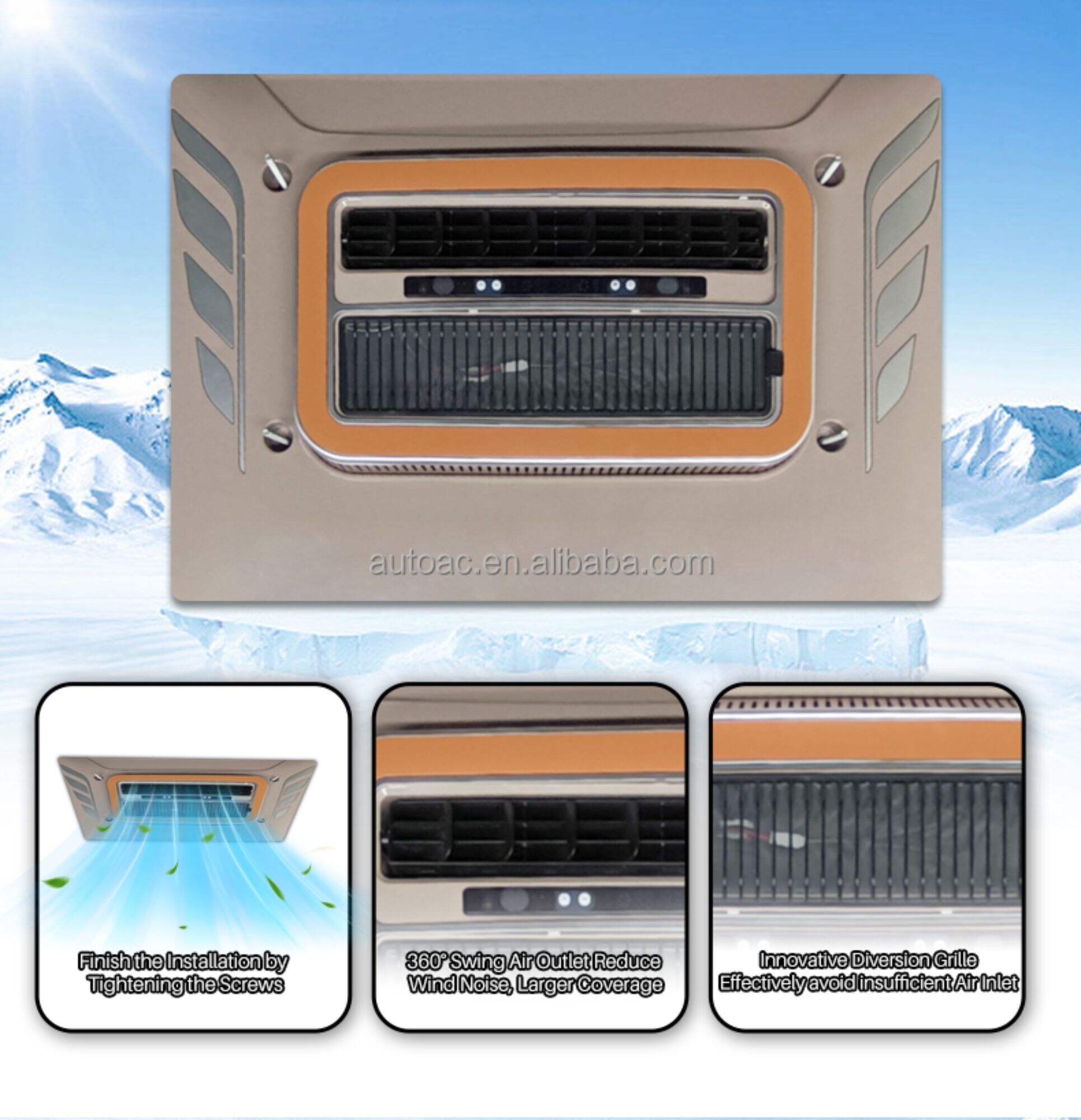Battery Powered Ac Unit For Car

Imagine stepping into your car on a sweltering summer afternoon. The sun has been beating down relentlessly, turning your vehicle into a veritable oven. But instead of bracing for a blast of superheated air, you're greeted by a cool, refreshing breeze. This isn't a scene from a futuristic movie; it's the potential reality offered by the burgeoning market of battery-powered AC units for cars.
Battery-powered AC units for cars promise a new era of comfort and efficiency, especially for those seeking alternatives to traditional, fuel-guzzling systems. These units offer a way to stay cool without idling the engine, reducing fuel consumption and emissions, making them a compelling option for a growing number of drivers.
The Rise of Battery-Powered Comfort
The quest for more efficient and environmentally friendly vehicle climate control has been ongoing for decades. Traditional car AC systems are powered by the engine, drawing significant power and, consequently, reducing fuel economy. This inefficiency becomes particularly noticeable when idling, such as in traffic jams or waiting for someone.
Early attempts to address this included auxiliary power units (APUs) for trucks and larger vehicles, but these often relied on small diesel engines. While offering some benefits, they still produced emissions and noise. The advent of advanced battery technology, particularly lithium-ion batteries, has paved the way for truly portable and efficient electric AC units.
Several factors have contributed to the growing interest in battery-powered AC units. Increased awareness of climate change and air pollution has driven demand for greener transportation solutions. Simultaneously, advancements in battery technology have resulted in lighter, more powerful, and more affordable batteries. This combination of environmental consciousness and technological feasibility has created a fertile ground for innovation.
How Battery-Powered AC Units Work
Battery-powered AC units for cars operate on a relatively straightforward principle. They utilize a compressor, condenser, evaporator, and expansion valve, similar to traditional AC systems. However, instead of being powered directly by the engine, the compressor is driven by an electric motor that draws power from a battery pack.
These battery packs can be charged in various ways: via the car's alternator while driving, through a standard AC outlet, or even with solar panels. Some units are designed as standalone systems that can be easily installed and removed, making them ideal for occasional use or for vehicles without existing AC.
The efficiency of these units depends on several factors, including the size of the battery pack, the power consumption of the compressor, and the insulation of the vehicle. More efficient units use advanced compressors and smart control systems to minimize energy usage and maximize cooling performance.
Benefits and Advantages
The advantages of battery-powered AC units are numerous. Perhaps the most significant is the reduction in fuel consumption. By eliminating the need to idle the engine for cooling, drivers can save a considerable amount of fuel, particularly in urban environments with frequent stops and starts.
Lower emissions are another key benefit. Reducing engine idling directly translates to fewer pollutants released into the atmosphere, contributing to cleaner air and a smaller carbon footprint. This is particularly important in densely populated areas with air quality concerns.
These units can also provide a quieter and more comfortable experience. Without the engine running, there's no engine noise or vibrations, creating a more peaceful environment inside the car. This can be especially beneficial for drivers who spend long hours on the road.
For owners of electric vehicles, battery-powered AC units offer a way to conserve their main battery pack's energy. Using a separate battery for cooling allows them to extend their driving range, particularly during hot weather when AC usage is at its peak.
Potential Drawbacks and Challenges
Despite the numerous benefits, battery-powered AC units also have some potential drawbacks. The initial cost can be higher than traditional AC systems, although prices are expected to decrease as technology advances and production scales up.
The runtime of these units is limited by the capacity of the battery pack. While some units can run for several hours on a single charge, others may require more frequent recharging, especially in extreme heat. Users need to carefully consider their needs and choose a unit with adequate battery capacity.
Installation can also be a challenge, depending on the type of unit and the vehicle's design. Some units are designed for easy DIY installation, while others may require professional installation, adding to the overall cost.
The weight and size of the battery pack can also be a concern, especially for smaller vehicles. Users need to ensure that the unit can be safely and securely installed without compromising the vehicle's handling or cargo space.
The Market Landscape and Key Players
The market for battery-powered AC units is still relatively nascent, but it's growing rapidly. Several companies are now offering a range of products, catering to different needs and budgets. Nomadic Cooling, Zero Breeze, and RIGd Supply are among the brands gaining traction in this space. These companies offer various models ranging from portable, window-mounted units to more integrated systems.
The automotive industry itself is also taking notice. Major automakers are investing in research and development of advanced climate control systems, including electric compressors and more efficient heat exchangers. As electric vehicles become more prevalent, the demand for efficient and sustainable cooling solutions will only increase.
The growth of the market is also being driven by government regulations and incentives. Many countries and regions are implementing stricter emission standards and offering subsidies for electric vehicles and energy-efficient technologies. These policies are creating a favorable environment for the adoption of battery-powered AC units.
Looking Ahead: The Future of Car Cooling
The future of car cooling is undoubtedly electric. As battery technology continues to improve, we can expect to see more powerful, efficient, and affordable battery-powered AC units. These units will become increasingly integrated into vehicle designs, offering seamless and convenient climate control.
We can also anticipate advancements in smart control systems that optimize cooling performance based on real-time conditions and user preferences. These systems will use sensors to detect temperature, humidity, and occupancy, adjusting the cooling output accordingly to minimize energy consumption.
Solar-powered AC units are another promising area of development. Integrating solar panels into the vehicle's roof or body panels could provide a sustainable source of energy for cooling, further reducing reliance on the grid or the car's alternator.
Beyond personal vehicles, battery-powered AC units also have potential applications in commercial vehicles, recreational vehicles, and even emergency shelters. Their portability and independence from the grid make them a versatile solution for a wide range of cooling needs.
A Cool Change on the Horizon
The emergence of battery-powered AC units for cars represents a significant step towards a more sustainable and comfortable driving experience. While challenges remain, the benefits of reduced fuel consumption, lower emissions, and quieter operation are undeniable. As technology continues to evolve and prices become more competitive, these units are poised to become an increasingly common sight on our roads.
The ability to step into a cool car without contributing to pollution or wasting fuel is no longer a distant dream. It's a rapidly approaching reality, driven by innovation and a growing awareness of the need for a greener future. The heat is on, but thanks to battery-powered AC units, we're finally starting to cool things down.















![Battery Powered Ac Unit For Car The 6 Best Battery Powered Air Conditioner Units [2024]](https://www.essentialhomeandgarden.com/wp-content/uploads/2022/04/best-battery-powered-air-conditioner.jpg)


